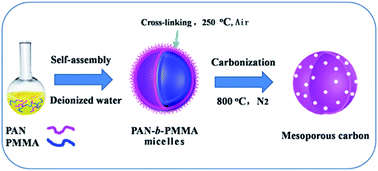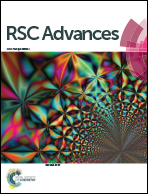Controllable synthesis of mesoporous carbon nanoparticles based on PAN-b-PMMA diblock copolymer micelles generated via RAFT polymerization as electrode materials for supercapacitors
Abstract
Mesoporous carbon nanoparticles (MCNs) were prepared through a series of annealing procedures using well-controlled diblock copolymer micelles as precursors. The micelles were prepared from poly(acrylonitrile)-block-poly(methylmethacrylate) (PAN-b-PMMA), and synthesized via reversible addition–fragmentation chain transfer (RAFT) polymerization. The RAFT-controlled synthesis of block copolymer, PAN-b-PMMA was conducted either in solution or emulsion conditions. It was found that micelles with well-defined morphology could be directly formed from the emulsion polymerization. The as-synthesized micelles containing hydrophilic PAN corona as the carbon source and hydrophobic PMMA core as the sacrificing template underwent a microphase-separation process to form a nanostructure at 250 °C, followed by carbonization at 800 °C to afford MCNs. What's more, the MCNs based supercapacitor exhibited a good capacitance value of 220 F g−1 and an excellent cycling performance of 91% capacitance retention after 10 000 cycles. The as-prepared MCNs are envisioned to provide broad practical applications in the fields of energy storage and nanotechnology.


 Please wait while we load your content...
Please wait while we load your content...